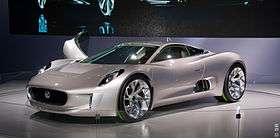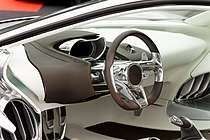Jaguar C-X75
| Jaguar C-X75 | |
|---|---|
 | |
| Overview | |
| Manufacturer | Jaguar Cars |
| Production |
2010–2013 (1 concept car + 5 developmental prototypes)[1] |
| Designer | Ian Callum |
| Body and chassis | |
| Class | Concept car / Sports car (S) |
| Body style | 2-door coupé |
| Layout | rear mid-engine, four-wheel drive |
| Powertrain | |
| Engine |
|
| Electric motor |
|
| Power output |
|
| Transmission | 7-speed automated manual[2] |
| Battery | 19 kWh liquid-cooled lithium-ion battery[2] |
| Range |
|
| Dimensions | |
| Length | 4,646 mm (183 in)[2] |
| Width | 2,040 mm (80 in)[2] |
| Height | 1,160 mm (46 in)[2] |
| Curb weight | 1,700 kg (3,748 lb)[2] |
| Chronology | |
| Predecessor | Jaguar XJ220 (spiritual) |
Jaguar C-X75 is a hybrid-electric, 2-seat, concept car produced by Jaguar Cars in partnership with Formula One team Williams F1 which debuted at the 2010 Paris Motor Show. The C-X75 concept produces 778 horsepower through four YASA electric motors,[3] each of which drives one of the four wheels. The batteries driving these motors are recharged using two diesel-fed micro gas turbines instead of a conventional four-stroke engine.[4] It was described as a design study that would influence future design and technology.[5]
In May 2011 Jaguar announced a limited production of the C-X75 from 2013 to 2015, with a downsized, forced induction petrol engine combined with electric motors instead of the micro gas turbines in the concept car. The price of the plug-in hybrid sports car was estimated between GB£700,000 – GB£900,000 (US$1.15 – US$1.48 million) depending on local market and taxes. A maximum of 250 cars were planned to be built in partnership with Formula One team Williams F1. The production version was expected to have an all-electric range of 50 km (31 mi).[6][7] In December 2012, the company announced the cancellation of production due to the ongoing global economic crisis. Five developmental prototypes were produced in the production car specifications in 2013.[8] The car was featured in the 2015 film Spectre, the twenty-fourth James Bond film in which seven cars were supplied to the film makers.[9]
Engine and performance




In terms of performance, Jaguar envisioned a goal of their future super car reaching 330 km/h (205 mph) and accelerating from 0 to 100 km/h (0 to 62 mph) in 3.4 seconds and 80 to 145 km/h (50 to 90 mph) in 2.3 seconds. It is powered by four 145 kW (194 hp) electric motors – one for each wheel – which produce 780 hp (582 kW) and a total torque output of 1,600 N⋅m (1,180 lbf⋅ft). Inherent in the drivetrain is the ability to independently drive each wheel across the full speed range, known as Torque Vectoring.[10][11] Each motor weighs 50 kilograms (110 lb).[5] The micro gas turbines from Bladon Jets generate enough electricity to extend the range of the car to 900 km (559 mi) while producing 28 grams of CO2 per kilometre on the EU test cycle. While running solely on battery power, the C-X75 has an all-electric range of 110 km (68 mi).[10][11] Among other advantages, the micro turbines used in the C-X75 can be run on a range of fuels including diesel, biofuels, compressed natural gas and liquid petroleum gas.[11] The 15kWh lithium ion battery pack weighs 185 kilograms (408 lb).[5] Jaguar estimates an average carbon emission of 28 g/km on European test cycle, however, the carbon emission is around 150g/km if the turbines are running.[12]
Jaguar also focused on the aerodynamics in order to improve performance. For example, the carbon-fibre rear diffuser that guides airflow from under the car creating down-force, and includes an active aerofoil and is lowered automatically as speed increases. Moreover, the C-X75 features an extruded and bonded, aerospace-inspired, aluminium chassis, saving on weight and improving sustainability and performance.[11]
Production
In May 2011 Jaguar unveiled plans to produce the C-X75 costing GB£700,000 (US$1.15 million). The company planned to produce a maximum of 250 cars in partnership with Formula One team Williams F1. The decision was part of a GB£5 billion investment plan, announced by Jaguar Land Rover (JLR) in March 2011 at the Geneva Motor Show, to launch 40 "significant new products" over the next five years. The model was scheduled to be built from 2013 until 2015, although it had not yet been decided where the production would take place.[6][7]
The C-X75 was to be built without the micro-turbines, instead, the production version would use a downsized, forced induction petrol engine, with one electric motor at each axle. In order to create a lightweight strong structure, the chassis was planned to be made of carbon-fibre, and the engine was to be mid-mounted for optimum weight distribution and to retain the concept’s silhouette. The C-X75 production version was expected to deliver CO2 emissions of less than 99 g/km, a sub-three second 0–60 mph acceleration time, a top speed in excess of 200 miles per hour (320 km/h) and a reduced all-electric range of 50 km (31 mi) as compared to the 110 km (68 mi) for the concept car.[6]
Cancellation
In December 2012, Jaguar's Global Brand Director announced the cancellation of production due to the ongoing global economic crisis, as the carmaker considered that " it seems the wrong time to launch an £800,000 to £1 million supercar." The company expected to take advantage of part of the investment in the C-X75 development by using the C-X75 technology in future Jaguar cars. The hybrid technology could be used on a three-cylinder engine to give it the power of a six-cylinder engine, and the C-X75's sophisticated aerodynamics should also influence future Jaguar cars, while the high-pressure supercharger technology could be used on future performance Jaguar cars with four-cylinder engines. The Jaguar F-type was heavily influenced from the C-X75 and carried over many design cues and technological features from it. Jaguar announced its decision to continue working on five prototypes to be developed until May 2013. These prototypes featured a 1.6-litre turbocharged and supercharged inline-4 engine coupled with two YASA electric motors placed on each axle of the car. The powertrain had a combined power output of 890 hp (902 PS; 664 kW) at 9,000 rpm and helped the car achieve speeds up to 200 mph (322 km/h). Up to three of these prototypes were then sold at auction, while one went to a future Jaguar museum, and the one was kept by Jaguar for running demonstrations. One of these prototypes was also featured in the 2015 James Bond film, Spectre.[8]
Appearance in Spectre
.jpg)
A Jaguar C-X75 appears in the 2015 James Bond film Spectre as Mr. Hinx's car. It takes part in a car chase around Rome against James Bond, who drives an Aston Martin DB10. Jaguar supplied seven examples to the filmmakers. Although the cars are visually faithful to the original C-X75 concept, they are mechanically unrelated. According to JLR Special Vehicle Operations chief John Edwards, the cars are "constructed around a spaceframe built to World Rally Championship spec" and powered by a turbocharged and supercharged 1.6-litre engine coupled with two electric motors. Although this new appearance of the C-X75 led to speculation that production plans for the car were being revived, Edwards was quoted as saying "the film was an opportunity to showcase C-X75, but it doesn’t mean a change in strategy."[13] The car was built in collaboration with Williams F1.[2] The C-X75 was also included in the 2018 video game Forza Horizon 4 as part of the "Best of Bond" car pack.
See also
- Jaguar C-X16 – Jaguar's smaller 2011 hybrid 2-seat sports car concept
- List of modern production plug-in electric vehicles
References
- ↑ Korzeniewski, Jeremy (2012-12-11). "Jaguar C-X75 production run canceled". Autoblog.com. Retrieved 2013-06-22.
- 1 2 3 4 5 6 7 8 9 Pulman, Ben (2013-06-21). "Jaguar C-X75 (2013) review". CAR magazine. Retrieved 2018-03-12.
- ↑ "YASA Motors' Work for Jaguar Land Rover Wins Industry Commendation" (Press release). YASA. 2013-11-26. Retrieved 2016-07-08.
- ↑ "First Look: Jaguar C-X75 Concept". Motor Trend. 2010-09-28. Retrieved 2010-10-09.
- 1 2 3 Tim Pollard (2010-10-01). "Jaguar C-X75 concept (2010) diesel electric supercar". CAR magazine.
- 1 2 3 "Jaguar to build C-X75 hybrid supercar with Williams F1". Green Car Congress. 2011-05-06. Retrieved 2011-05-06.
- 1 2 Jorn Madslien (2011-05-06). "Jaguar to build £700,000 hybrid supercar with Williams". BBC News. Retrieved 2011-05-06.
- 1 2 Mark Tisshaw (2012-12-11). "Jaguar C-X75 axed". Autocar. Retrieved 2012-12-11.
- ↑ Moss, Darren (2015-02-09). "Jaguar C X75 in James Bond film Spectre". Autocar. Retrieved 2015-02-14.
- 1 2 Jerry Garrett (2010-09-29). "Jaguar C-X75 Concept Is a 205-M.P.H. Hybrid". New York Times. Retrieved 2010-10-06.
- 1 2 3 4 "Jaguar Introduces C-X75 Gas Micro-turbine Extended Range Electric Vehicle Concept". Green Car Congress. 2010-09-30. Retrieved 2010-10-06.
- ↑ Steve Cropley (2010-12-03). "Jaguar C-X75 Concept First Drive". Edmunds InsideLine.
- ↑ Tisshaw, Mark (2015-10-16). "Aston Martin DB10 special – from Gaydon with love". Autocar. Retrieved 2015-10-27.
External links
| Wikimedia Commons has media related to Jaguar C-X75. |